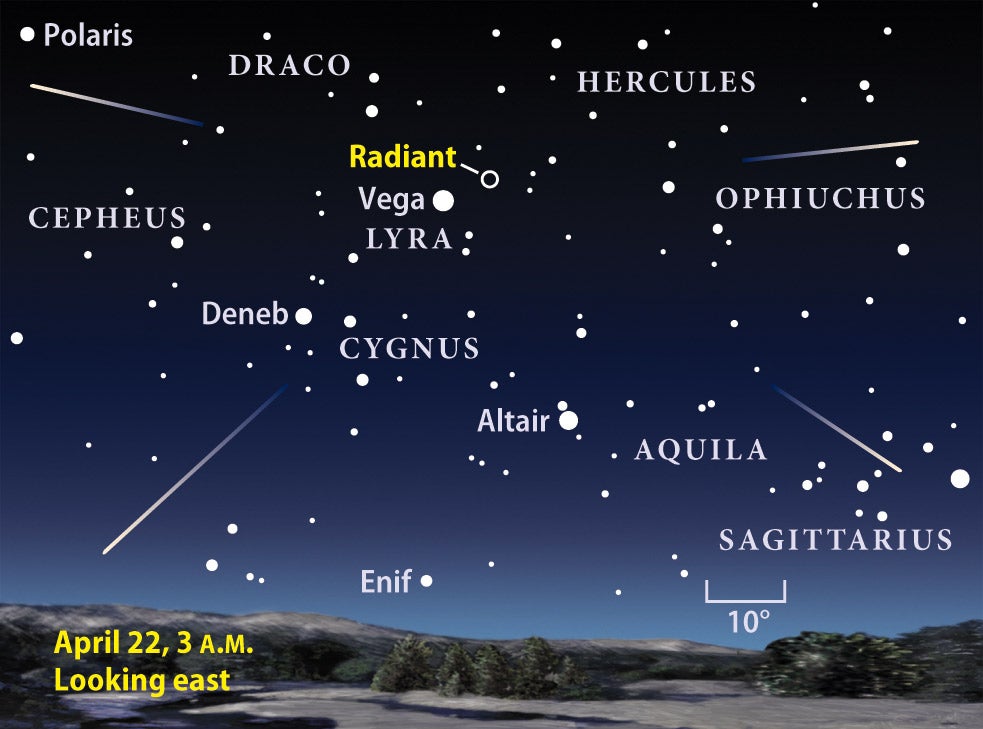
Interesting facts about meteors
- Most visible meteors lie within 120 miles (200 kilometers) of an observer.
- Meteors become visible at an average height of 55 miles (90 km). Nearly all burn up before they reach an altitude of 50 miles (80 km).
- No known meteorite has been associated with a meteor shower. (That is, no shower meteor has ever survived its flight through the atmosphere and been recovered.)
- The typical bright meteor is produced by a particle with a mass less than 1 gram with a size no larger than a pea.
- The average total mass of meteoritic material entering the Earth’s atmosphere is estimated to be between 100 and 1000 tons (91,000-910,000 kilograms) per day.
- The hourly rate on a “non-shower” night is approximately 6 meteors per hour.
- A meteoroid enters the atmosphere at velocities between 25,000 and 165,000 mph (40,300-265,000 km/h).
Expand your observing with these online tools from Astronomy magazine
- Video: How do observe meteor showers
- StarDome: Locate the Geminid meteor shower’s radiant in your night sky with our interactive star chart.
- Sign up for our free weekly e-mail newsletter.
April 15, 2010
Streaking swiftly across the sky, motes of dust burn up as meteors. Although Earth constantly sweeps up interplanetary dust, our planet runs through a slightly denser trail this month. Named after the constellation from which the meteors appear to radiate, the Lyrids peak April 22, one day after the Moon reaches its first quarter phase.
Lyra is easy to find because it’s marked by the brilliant blue-white star Vega. Vega ranks fifth-brightest of all nighttime stars.
The Lyrid shower produces meteors from April 16 to 25 and peaks with about 20 meteors per hour after midnight April 22. The Moon’s first-quarter phase occurs April 21. This year’s viewing prospects are good because the Moon sets each night before the best meteor activity.
The radiant — the point in the sky where the meteors seem to come from — lies in the small constellation Lyra the Lyre (harp). The Lyrid’s radiant is high in the sky by midnight, local daylight time April 22, around the time the Moon dips below the western horizon. The highest hourly rates occur a few hours before dawn, when Lyra rides high in the sky.
Rates can reach 20 meteors per hour, and occasionally more. During the past several decades, observers have reported sporadic outbursts that pushed hourly rates past 60 meteors. The predawn hours offer the best viewing because that’s when your location will be facing Earth’s direction of travel. In essence, Earth will be running into the meteors.
Lyrid meteors are fast and average as bright as the Big Dipper’s stars. The particles we see as meteors originated from Comet Thatcher (C/1861 G1). This shower occasionally displays outbursts, with peak hourly rates above 60 meteors.
It’s best to view meteor showers without optical aid. Viewers should use just their eyes so as not to restrict the field of view. Before midnight, face eastward, and look about halfway up. After midnight, looking overhead will probably net you the most meteors.
Meteor showers are great social and family events. Organize a group of skygazers, and head out of town to a dark location. Bring lawn chairs, sleeping bags, and hot drinks to stay warm. Plan to wear winter clothing — many observers are surprised at the chill of spring’s late-night air.









